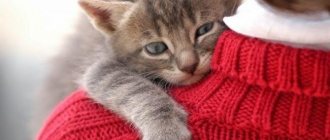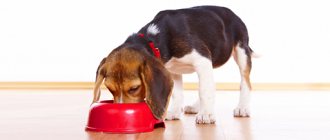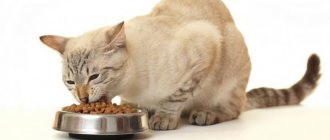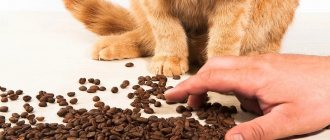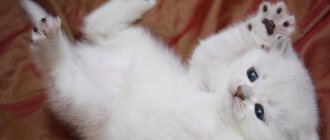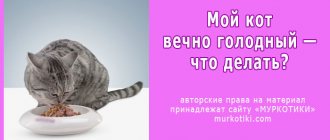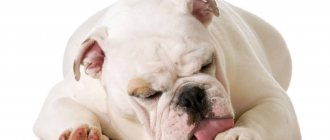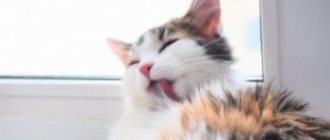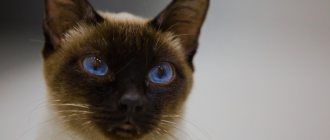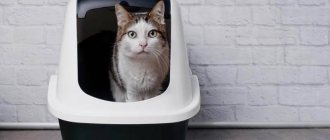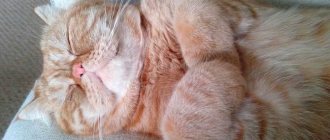The reasons why a cat refuses to eat dry food can be varied. Perhaps the pet does not have enough fluid in its diet, and by consuming dry food, the animal experiences even greater thirst. An old cat does not want to chew solid food due to problems with his teeth, which become less strong with age and often hurt. Sometimes a cat does not eat well even a good store-bought product due to poor health caused by the progression of a dangerous internal disease in the body. The veterinarian will tell you what to do in such situations after examining your pet.
Feed quality
Food, including dry food, is made from meat, but there is no way to preserve all its properties forever. Dry diet granules are treated with vitamin E; this is a useful and reliable preservative, but its validity period is limited and is approximately equal to the shelf life of the feed. Then the fats in the “drying” begin to decompose. The cat hears an unpleasant odor, feels a rancid taste and refuses to eat. The taste of canned food and spiders deteriorates in the same way after the expiration date. The answer to the question “why doesn’t the cat eat the food” can often be found in the “use before” line.
The food is not suitable for the cat
As we noted above, a cat's appetite is controlled by its sense of smell. A cat, like any predator, needs meat, and he determines how much of it is in a product by smell. If the food smells like grain, you shouldn’t be surprised at your pet’s poor appetite. Persuasion will not help here: cats act according to their instincts, which allowed them to survive in the harsh conditions of the wild.
Signs that the food is not suitable for your cat:
- The cat always ate this dry food reluctantly, but now he has stopped altogether;
- the diet contains little meat and a lot of grains;
- there are no animal fats in the food: they are partially or completely replaced by vegetable oils;
- the ingredients are named in groups with general words, for example “meat and its derivatives”, “offal”, “poultry meal”, which indicates the low quality of the ingredients used.
Solution
Carefully study the composition of the product you feed your pet. We wrote earlier about what good cat food should be like. If the composition turns out to be unsatisfactory, the diet will have to be changed to a higher quality one.
Improper storage
Dry food loses flavor if kept outdoors. If your cat does not eat dry food that you bought in bulk, it may well be that the store did not carefully close the bag. For the same reason, you should not buy a year's supply for your pet: there is a high risk that you will have to throw away half of it. Opened canned food will only take a few hours at room temperature to become unusable. If you see that the cat has stopped eating wet food and has gone about his business, it is better to put the bowl with the leftovers in the refrigerator.
Reasons why a cat may refuse dry food
There are many reasons that can cause a cat to refuse pelleted food. Some of them are associated with natural physiological factors, others are not normal and can threaten the cat’s life.
Diseases
Many diseases can provoke a refusal of dry food. The owner needs to pay attention to the general condition and behavior of the animal. If the cat is interested in the food, sniffs it and tries to eat, but at the last moment turns away or spits out the pellets, this may indicate damage to the gastrointestinal tract or the presence of a foreign body or neoplasm in it.
With dermatological diseases affecting the area around the mouth, the cat retains its appetite, but cannot eat due to pain
Pathology can affect not only the intestines or mucous membranes of the esophagus and stomach, but also the oral cavity. Animals often refuse dry food due to toothache. At first it causes discomfort, but the cat continues to eat. Later, as the pain intensifies, a kind of reflex arises, and the pet turns away from food. Interest in wet food and natural products can be maintained: softened food causes less discomfort. With dental diseases, a pet may chew on hard objects in order to independently get rid of the source of pain. Most often, an injury or signs of pathology can be detected by visual examination, but in some cases an x-ray is required.
Tartar can lead to the loss of fangs, so regular brushing with a special brush is recommended.
New growths in the oral cavity can cause no less discomfort. During eating, they can be injured by teeth or hard granules. In some cases, this can cause bleeding. Most often, tumors can be detected independently. They can be soft, hard, movable, fixed, white, black, etc.
Depending on the location of the tumor, the animal may experience increased salivation and difficulty swallowing
With diseases and damage to the musculoskeletal system, a cat may refuse dry food and other food while maintaining appetite due to limited mobility and pain. In such cases, the animal experiences severe discomfort, meows, limps, drags its paws or cannot rise at all, defecates under itself, etc. The condition is one of the most dangerous, so it is important to carefully deliver the cat to the veterinarian without causing it additional pain.
In some cases, the animal completely refuses dry food. It has no interest in it or other food. The pet is hungry, but at the sight of food it immediately turns away or leaves. This symptom may accompany the following diseases and conditions:
- Intoxication. Poisoning is accompanied by rapid heartbeat, nausea, vomiting, digestive disorders, fever, etc. In severe cases, loss of orientation in space occurs. In a critical condition, the cat stops reacting to what is happening, and the body temperature drops. Possible failure of internal organs. In case of mild intoxication, after the poisoning is removed, the condition returns to normal without additional intervention. If the cat’s health deteriorates significantly, the cat is fed through a tube and given intravenous infusions to prevent dehydration.
- Lipidosis. The disease is characterized by excessive accumulation of fat in the liver. The animal may eat poorly or completely refuse food for a long period of time (2-4 weeks or more). The cat quickly loses weight, and the ribs, breastbone and hips become visible. The animal is worried about digestive disorders and jaundice. In case of lipidosis, appetite must be corrected as part of general therapy, since irreversible processes often begin to occur in the body.
- Internal injuries. The main signs of illness are hidden bleeding, swelling and severe pain. If the cat's gastrointestinal tract is damaged, blood may be detected in the stool. In the absence of severe exhaustion, the animal’s condition returns to normal on its own after treatment.
If the tissues of the urinary system have been injured, blood impurities or solid clots will be present in the urine; indirectly, color allows you to determine the location of damage
- Infections. The reason for refusing dry food can be both gastrointestinal lesions and, for example, cystitis. In this case, poor appetite is associated with intoxication of the body by bacteria and their decay products. The animal definitely needs treatment, even if the symptoms have weakened or disappeared without treatment. Improvement in condition may indicate that the disease has become chronic.
- Gastrointestinal pathologies. The pet does not eat well or refuses dry food due to inflammation and pain in the abdomen, as well as nausea. If an animal eats both pellets and natural products, it may choose the latter. Foods that are high in liquid cause less pain due to their softer texture.
When feeling nauseous, your cat will often lick its nose.
- Disorders of the central nervous system and brain. Most often this is observed with injuries. Appetite problems are associated with impaired transmission and recognition of nerve signals. As a result, the cat does not feel hungry while the body needs energy and nutrients. Treatment is mandatory; if necessary, the pet is fed through a tube.
- Helminthiasis. Infection with worms can occur through eating raw meat, contact with other animals, or accidentally ingesting parasite larvae along with insects, soil or water. With mild helminthiasis, weight loss, deterioration in general health, and mucus and blood in the stool are observed. Larvae or whole worms may be found in natural secretions and vomit. In severe cases, worms cause intestinal obstruction. After taking anthelmintics twice, the symptoms disappear; only animals in critical condition need additional correction.
- Inflammatory processes that accompany acute and chronic diseases. Deterioration of appetite can occur with any pathology due to the active functioning of the immune system. Most of the energy is spent by the body on eliminating inflammation, so the pet feels weak and loses its appetite.
- Intestinal obstruction. Refusal of dry food is associated with blockage of the gastrointestinal tract and the impossibility of normal movement of food and feces. In such cases, the cat experiences pain. With partial obstruction, the animal is bothered by bloating and diarrhea, with complete obstruction - constipation. Nausea appears. Without help, the pet may die. After normalization of the condition, the cat gradually returns to a normal diet.
Partial refusal of dry food and selectivity may be caused by visual or olfactory impairments. In this case, this is due to the unattractiveness of the food. Cats navigate by sight and smell, so if they lose their senses, they may suffer from poor appetite. If the situation does not improve after normalization of the pet’s condition and a course of therapy, owners are advised to use additional tricks to increase the attractiveness of the food.
One day my cat started refusing dry food. At first I didn’t suspect anything, because approximately every 2 months she arranges several fasting days for herself: she eats less or goes hungry altogether. When problems with appetite began to become permanent, I became wary and decided to examine the cat: I carefully felt her stomach, looked into her ears and eyes, and checked her skin. The reason became clear when it came to the mouth. There were tartar on the chewing fangs, the gums around were red, and one of the teeth was loose. When I began to analyze, I remembered that recently the cat was often mischievous: she chewed wires, headphones, and even ruined several pairs of shoes, which was unusual for her. After removing the problematic fang, ultrasonic cleaning and treatment with dental gels, the appetite gradually returned to normal.
Lack of experience
Refusing food if the cat has not tried pellets before is a normal reaction. The animal understands that it is edible, but the unusual smell and consistency repels it. The cat will not die of starvation and sooner or later will begin to eat dry food, but a gradual transition is preferable. Otherwise, due to a sudden change in the menu, the animal may suffer from digestive disorders, exacerbation of chronic pathologies and the development of new diseases.
Spoiled food
Dry food remains conditionally suitable for consumption for 2–3 years, however, after opening the package, the shelf life is greatly reduced. This is due to the fact that the granules contain oils. When exposed to air, they quickly oxidize and go rancid. Depending on the storage method, the food will spoil after 3–8 weeks. Once rancid, it should not be given to cats as it may cause poisoning.
It is strongly recommended to refuse to buy food in bulk, especially if we are talking about super-premium class or higher: it is not known how long ago the package was opened
When I got my second cat, my dry food consumption increased. I decided to save money: buy large packages. This made it possible to reduce the cost of 1 kg of feed by an average of 20%. However, within a month the cats did not have time to eat all the contents. About a third of the volume remained in the bag when they both refused food. At first I thought they just didn't want to eat, but after a day it became obvious that something was wrong. When I gave the cats wet food, they readily ate it, as well as kibble from another package. We had to get rid of spoiled food. Now I buy small packages and make sure they have a zip closure. It partially prevents contact with air, so it does not allow the feed to spoil prematurely.
Pickiness
Cats are somewhat like children: if they understand that they can get something tasty, they will strive to achieve this by any means necessary. Whims are also on the list. If a cat once refused dry food, and the owner began to offer her delicacies or spoon-feed her, she will remember this. In the future, the pet will copy the previous behavior in order to get attention and extra treats.
Feeding "from the table" is fraught with begging and even theft
Animals can be very stubborn in their whims. Once upon a time one of my cats was sick. To make sure she got something to eat, I gave her her favorite wet food and dried chicken pieces. The cat recovered, but a month later she went on a hunger strike. I was afraid that she might start to lose weight, so I started giving her treats again and took her to the vet. The specialist said that everything was fine with the animal and advised him to ignore pickiness and just leave the food freely available. For about 2 days the cat became stubborn. I felt sorry for her, I constantly wanted to feed her, but I listened to the veterinarian. After this, the cat began to eat the pellets with the same appetite.
Getting used to flavor enhancers
Getting used to flavor enhancers can be a problem when switching from one food to another. Most often, this is encountered by those owners whose cats previously ate economy-class products.
Economy-class food for cats can be compared to fast food for people: there is little useful in them, but after such nutrition it is difficult to switch the animal to a healthy diet
Animals completely ignore the bowl of new food until hunger becomes unbearable. The owner's behavior should be the same as in the previous case: it is recommended not to pay attention to pickiness and observe so as not to miss uncharacteristic symptoms that may indicate illness. It is advisable to gradually switch your pet from one food to another.
Stress
Cats, like people, can experience problems with their appetite when they are mildly ill, in a bad mood or under stress. Since animals are conservative, even insignificant events for us can cause a behavioral disorder. For example, the arrival of a child or a new pet for neighbors, the relocation of some family members, or the rearrangement of furniture.
On the upper floors of the play complex the cat will feel as comfortable as possible, because from there she can watch what is happening from above
To normalize the condition, it is recommended to give the cat its own territory, where no one will disturb it. This will protect your pet from unwanted attention and help improve sleep. This is especially important if the family has small children, dogs or other cats. It is advisable to purchase a play complex or house. This is more aesthetically pleasing, although for cats even a cardboard box is a shelter. It is recommended that restless animals be crate trained from childhood to protect them from accidents. While the owner is not at home, the cat may chew through the wires or fall out of the window. The cage prevents this and serves as a kind of personal room for the pet.
When animals are stressed, they have problems sleeping: it becomes superficial, so the pet doesn’t get enough rest, which further aggravates the situation.
To combat stress, it is recommended to pay more attention to the cat, talk to it, play and pet it more often. This will allow the pet to feel like part of the family and strengthen its position in the “pack”. These measures cannot be ignored if stress is associated with the appearance of a new animal. Otherwise, the pets will begin to sort things out among themselves and become aggressive.
Malaise and poor appetite may be associated with other stress factors. For example, heat, pregnancy or recent vaccination. In such cases, it is necessary to alleviate the pet’s condition with the help of appropriate measures: arrange a cool shelter, prepare a nest for birth, provide comfort, etc. Gradually, the appetite returns to normal.
Sexual hunting
Estrus and heat are other factors that can cause a decrease in appetite without an immediate threat to health. Cats are designed in such a way that they are forced to reproduce by natural instincts, and not by feelings more common to humans.
Removal of genital organs is not a cruel measure, but an operation that helps a cat avoid discomfort during estrus, deterioration in health during childbirth and feeding kittens, and diseases due to hormonal fluctuations and infection.
When in heat, pets feel physical discomfort, which can be compared to the pain of cystitis. Only sexual intercourse can weaken it, so animals fully concentrate on sexual hunting. The remaining instincts weaken until the discomfort is completely eliminated and the heat is completed.
Fasting day
To improve digestion, some cats arrange fasting days on their own every few months. Most often this happens after eating fatty foods the day before. During fasting days, the pet refuses food partially or completely. Fasting normally lasts up to 2 days. During this time, it is important to provide your pet with access to clean water.
Eating disorder
The reason for refusing dry food may be the lack of a stable daily schedule. This includes both spontaneous feeding and feeding with food from the table. In the latter case, the cat may become picky. Unplanned meals can lead to a lack of hunger at the time of the main feeding. If you refuse to eat and there are no other symptoms, you should analyze the situation. Perhaps one of the family members feeds the cat from the table?
It is important for cats to live on a schedule. With a spontaneous daily routine, they may not have time to get hungry by the time they eat. A stable schedule allows you to maintain normal appetite of the animal. Its internal organs adapt and begin to secrete digestive fluids strictly at the same time, which contributes to the feeling of hunger at the right time.
The reason is in the bowl (dirty, smelly, etc.)
Cats are extremely clean animals. Their sense of smell is much sharper than that of humans, so they are able to smell even a faint odor. A pet may stop eating its usual food because the owner rarely washes the bowl or it smells unpleasant for reasons not related to untimely washing. Liquid from the bowl of water may leak into the container containing the dry granules. That is why it is recommended to place them at a certain distance from each other to eliminate this problem.
When moisture gets into the food, it begins to become damp. If the animal does not completely eat the food at one time, microorganisms grow in it, as a result of which it begins to smell unpleasant.
What can you do to restore your four-legged pet’s interest in food? To do this you need:
- Wash the bowl and pour boiling water over it. Subsequently, do this every day.
- Place the container of water away from the food bowl, making sure that the contents of the first cannot get into the latter. Some cat owners prefer to use double bowls. This is not the best option. It is recommended to feed cats from separate bowls.
- Pour into the bowl exactly as many granules as your pet can eat at a time. If he has not finished eating, it is recommended to pour the food back into the storage container, discarding the top layer on which the animal’s saliva has fallen.
- When purchasing food bowls, give preference to glass or stainless steel ones. Plastic containers may smell unpleasant. In addition, plastic is porous and almost impossible to wash clean.
Accustoming a kitten or adult cat to dry food
In the case of kittens, the process is usually easier, since in childhood animals are more prone to rapid adaptation. Adult cats are less willing to switch to dry food, but in the absence of contraindications and health problems, you just need to be persistent.
Kittens can be given dry food from 3 weeks, but it is advisable to start training from 4–6 weeks. This allows the gastrointestinal tract to fully develop and prevents the occurrence of diarrhea and dehydration. Training begins with 1–2 granules. Dry food must be soaked before offering it to the kitten. It is recommended to do the same in the case of adult cats: due to the increased level of humidity, the consistency will be more familiar to the animal.
When choosing food for a kitten, you need to pay attention to the manufacturer’s recommendations: depending on the composition, he may recommend starting to give the product at 3, 4 or 8 weeks
The proportion of dry food and the amount of added water are gradually reduced. By the time the kitten’s teeth change, they are switched to granules in their original form. The menu at this time includes wet and dry food of the same brand or only the latter. The norm is calculated according to tables and individual characteristics, based on physique.
For older cats, you can use treats. For example, it produces spices. On sale you can find special sauces and gravies, dried pieces of meat, etc. It is allowed to mix slightly soaked granules into regular food so that the pet gets used to the taste. Treats are given exclusively in dehydrated form. This helps reinforce positive associations. The dosage of treats should not exceed the recommended one.
Dried fillet pieces are an excellent choice when transitioning to dry food; they are a cross between natural meat and dehydrated pellets.
In some cases, it is necessary to select an individual approach. For example, start by grinding granules and mixing the powder into regular food. For picky pets, wet food can become an intermediate step during the transition. It is advisable to choose products from the same brand.
When to urgently contact a veterinarian
You can expect the condition to normalize on its own only if the cat feels well. Intervention is not required if the reason for refusal to feed is mild stress, selectivity or disruption of the daily routine. However, if uncharacteristic symptoms appear and prolonged fasting (more than 2 days for an adult cat, more than 6–12 hours for a small kitten), you must contact a veterinarian for examination.
An urgent visit to the clinic is mandatory in the following cases:
- The cat became dehydrated. It may appear due to vomiting, nausea, or refusal of water. The last symptom is the most alarming, since it indicates serious problems with the functioning of internal organs. Dehydration can kill your pet in a matter of hours due to blood thickening, so you should immediately contact your veterinarian for intravenous fluids. At home, it is allowed to inject Ringer-Locke solution into the withers, but it is better to first find out the cause of the ailment.
- The cat lies in one place, tries to stay closer to heat sources and reacts sluggishly to what is happening. In most cases, this indicates severe malaise and pain. Animals rarely complain of discomfort, since by their standards this is a weakness and can be fraught with death from the paws of another predator.
- The cat is behaving strangely. Sometimes pets meow pitifully, unable to withstand the pain or trying to communicate about it, but this is rare. Due to discomfort, the animal may ask to pet it or, conversely, not allow you to touch the problem area. Cats often become aggressive.
- The animal has a fever. The normal value for adult cats is considered to be +38…+39°C. In kittens, the temperature may be slightly higher - +38.5...+39.5°C. An increase of 1°C indicates the presence of inflammation, but is generally not life-threatening. If the temperature rises by 2°C, you should immediately consult a veterinarian. An increase of 3°C can be critical.
The most dangerous symptoms include vomiting, nausea, inability to empty the intestines or bladder for a long time (more than 2-3 days and 18-24 hours, respectively), disorders of the musculoskeletal system, etc. With itching, rash, For moderate diarrhea without dehydration and other mild manifestations, the cat can wait, but it is better to contact a veterinarian at the first opportunity, since even banal spots on the skin can indicate, for example, liver pathologies.
Lack of habit
Most often, a situation where a cat ignores dry food occurs if the animal was not accustomed to this product initially. At the same time, one should not conclude that the cat “considers” it to be unsuitable food; it’s just that, unlike wet foods, dry food smells different and has an unusual consistency.
All you need to do is get your pet used to a dry diet, starting with feeding food that the cat will eat with pleasure (this can be either canned pet food or a natural diet), and gradually adding dry food pellets to it.
At first, they should make up no more than 15-20% of the total serving volume, and then their number is gradually increased until complete replacement. On average, such a smooth transition takes one to two weeks.
If the cat is capricious and leaves dry food granules in the bowl, eating everything else, then you can act harshly by simply depriving the pet of any other food. A hungry animal will sooner or later start eating what is given.
Signal of malaise
Refusal of the usual food may indicate poor health of the animal and the development of a particular disease.
The danger of cheap food. For some time, the cat can be quite happy with its diet, regularly eating economy-class dry food. However, low-quality feeds laden with artificial additives have adverse effects, with response times ranging from a few hours to months or even years.
The cumulative negative impact imperceptibly destroys the animal’s body, causing disruptions in the functioning of organs and systems. In particular, cats that eat cheap dry food already at a young age suffer from kidney pathology, urolithiasis, gastritis, pancreatitis, allergic manifestations and skin problems. The worsening of the disease ultimately leads to poor health of the animal, accompanied by a refusal to eat.
Signs of the disease. Unfortunately, mustachioed striped animals are susceptible to a wide variety of diseases, including genetic pathologies, infections, helminthiases, metabolic disorders and all kinds of malfunctions of organs and systems. You can suspect something is wrong if a refusal to eat dry food is accompanied by:
- absolute loss of appetite and aversion to any type of food, including treats;
- increased body temperature;
- noticeable decrease in activity, lethargy and apathy;
- the desire to hide in a dark corner and stay there for a long time;
- drooling, vomiting and intestinal upset;
- copious discharge from the nose and eyes;
- unsteady gait, lack of coordination, convulsions;
- urinary retention, strong unpleasant odor of excreted urine, appearance of blood and pus in urine;
- severe difficulty breathing;
- swelling of the abdomen and limbs;
- the appearance of lumps, tumors and ulcers on the skin and body.
Prevention and treatment. To avoid health-related troubles, you must:
- Treat your favorite cats with suitable natural food or balanced premium and super-premium food that does not contain artificial colors or dangerous preservatives.
- Do not ignore even the most minor ailments of your pet, clearly monitoring his well-being.
- Have the contact details of a competent veterinarian at hand.
- If a particular pathology is detected, strictly follow the specialist’s recommendations, in particular diet and nutritional regimen.
Caring for your pet should be caring and feeding should be rational, which will ensure satisfactory health for many years.
The pet got sick and lost his appetite
Lack of interest in familiar food may be due to the pet’s unsatisfactory health due to a pathological process occurring in its body. Various diseases can provoke loss of appetite in a four-legged pet: disruption of the gastrointestinal tract, helminthic infestation, dermatological and dental pathologies, and much more.
Usually, loss of interest in food is not the only symptom of the disease. It may be accompanied by other signs:
- general deterioration in well-being (apathy, lethargy, lack of response to external stimuli, decreased physical activity up to its complete absence);
- change in behavior (anxiety, unmotivated aggression);
- increased body temperature;
- discharge from the nasal passages and eyes;
- deterioration of coat condition (loss of shine, loss);
- sores in the mouth;
- bad breath;
- attacks of nausea and vomiting;
- diarrhea or constipation;
- pallor of the mucous membranes;
- foreign inclusions in feces or urine (mucus, bile, pus), etc.
The listed symptoms are possible, but not required. What to do if your pet shows signs of illness? The only reasonable action of his owner in this situation is to contact a veterinarian. You cannot put off a visit to the veterinary clinic. Refusal of the usual food may signal a dangerous illness. It is necessary to identify the cause of loss of interest in food as quickly as possible and eliminate it.
Appetite decreases due to stress
The first thing new owners do is feed their pet. Having brought the kitten home, they pour him a whole bowl of food and expect him to immediately empty it. But at this time the baby is experiencing extreme stress: separation from his mother, moving to a new home, a complete change of environment. No wonder he has no time for food.
Take your time with feeding. Let the kitten explore the territory, come to terms with the separation, and get used to new people. If there are other animals in the house, keep them in another room for now. After an hour or an hour and a half, you can offer dry food: most likely, by this time the new pet will have worked up an appetite and will eat more willingly.
How and what to feed a sick cat?
High-quality, nutritious nutrition plays a huge role in maintaining a cat’s health and attractive appearance. But it becomes even more important when the animal develops health problems.
During periods of poor health in a pet, the owner must pay special attention to its diet and ensure that the weakened body receives a sufficient amount of vitamins and nutrients. And during recovery, animals require more healthy, nutritious food than usual.
Often this pet’s eating behavior is a consequence of various diseases, especially those related to the gastrointestinal tract, as well as other health problems:
- 1. A foreign object in the throat or esophagus that the animal cannot remove on its own.
- 2. Serious body bruise.
- 3. Poisoning.
- 4. Stress.
If a cat does not eat anything, it must be shown to an experienced veterinarian, undergo an examination and pass all the prescribed tests: blood, urine, ultrasound.
If the animal’s portions have been reduced during illness, then there is no need to panic.
It is important to ensure that your cat drinks plenty of water. This will help avoid dangerous dehydration.
If the pet categorically refuses any food intake, then in this case you will need to be patient and look for ways that will help feed the animal and prevent a lack of nutrients in its body. Among them:
- 1. Warm food, heated to approximately 39 ° C, becomes more aromatic and attractive to the cat.
- 2. If for some reason an animal has problems with its sense of smell, you should put small pieces of treats on its lips.
- 3. Sick cats are much more willing to eat liquid foods than solid ones, and they should become the basis of the diet.
- 4. If it is difficult for an animal to get up to get to the feeding area, the best solution would be to give it food from your hand, while stroking and calming the pet.
Sometimes the animal becomes so weak that it is unable to move independently or chew food. In this case, the owner must assist him in eating. It is convenient to use a miniature syringe for this. A 2 ml product will be sufficient.
The tip of the syringe is cut off with a knife, and the edges are cleaned so that they are not sharp. The tube is filled with liquid food, after which the product is brought to the animal’s nose. This is necessary so that your pet can smell the treat.
As soon as the cat opens her mouth a little, slowly squeeze a small portion of food onto her tongue. If the animal does not do this on its own, you will have to slightly open its jaws with your fingers. Do not press too hard to avoid causing pain to your pet. Otherwise, the next time the feeding procedure will cause negative emotions in him.
What to do in such cases?
Owners often prefer dry ready-made food not only because of ease of use. A high-quality store-bought product is balanced in composition, it includes vitamins, micro- and macroelements, and other useful substances necessary for the pet’s body.
For normal functioning, your pet may require holistic nutrition.
Some animals require a strict diet. Holistic food will fully satisfy the needs of your pet, while simultaneously providing its body with everything it needs. However, the animal does not always agree with the owner and goes on strike and refuses to eat dry food. In such situations, veterinarians advise soaking the product in water, milk or broth, then offering it to your four-legged friend. It is important to give your pet water regularly so that it is always available. In addition, you should constantly monitor the cleanliness of the dishes from which the cat eats, because if it is dirty, the animal may refuse to eat.
You should not suddenly switch from one type of food to another. It is recommended to gradually introduce a new product, adding a larger portion each time, until you can completely displace the usual food from the menu. In addition, veterinarians do not advise frequently changing brands of manufacturers. It is better to choose food together with your doctor, taking into account the individual characteristics of the cat’s body.
Health problems
A kitten’s refusal to feed often happens for reasons related to the health and well-being of the animal. Here are the most common ones.
- Poisoning.
Cats are by nature very curious creatures, what can we say about little kittens who want to taste everything in sight? It is quite possible that some bad product will come across and cause poisoning in a small cat. In this case, the cat will refuse any product. You should not force-feed him; it is better to take him to a veterinary clinic and show him to a specialist. He will select treatment methods and prescribe rehabilitation therapy. - Disease of the gums or teeth.
A cat may well get stomatitis. Then the food granules will begin to cause pain to the animal, and it will begin to refuse this food. - Helminthiasis.
A kitten, especially if it likes to walk outside, can very easily pick up worms or some other parasites. The owner can visually determine their presence, but it is better to contact a specialist who will conduct an examination and prescribe treatment.
The kitten is naughty
All family members want to pamper the baby, and this desire is quite understandable, but food is not the best, and in any case, not the healthiest way to show your affection. Communication and games are much more important to a kitten, but additional treats can only lead to overeating, although the dry food in the bowl will remain untouched.
Constant chaotic treats also have another danger - the kitten may begin to systematically “extort” tasty treats from each family member in turn, and they, out of the kindness of their hearts, will feed the pet everything that it does not ask for. This situation does not lead to anything good - from digestive disorders to the appearance of excess weight.
Do not follow the kitten’s lead, feed in accordance with the recommended norm, and if the baby is naughty, do not give him anything other than dry food, and warn all family members about this. As a rule, after a few hours of the fast, the appetite returns.
How much should you feed a kitten?
Newborn kittens are fed on their mother's milk and receive all their nutrition entirely from her. If for some reason the kitten does not have a mother, then they are fed with specialized formulas for kittens. Kittens are weaned from their mother at approximately three to four weeks of age, and from this point onwards they can be introduced to dry food in alternation or by mixing it with wet food.
You may like: What does a Himalayan bear eat?
Kittens need food rich in protein and calcium.
After he is weaned from his mother, he should not be given any more dairy products, especially cow's milk.
Once weaned from their mother, they can eat both dry and wet food. Start feeding him dry food that has been canned or soaked into oatmeal.
Over the next two weeks, gradually reduce the amount of water and increase the portion of food.
By six to eight weeks they will switch to dry food without any problems.
The amount of feed is indicated on the packaging by the manufacturer; follow these proportions.
The portion can be served immediately or divided into two portions.
What to do if your cat refuses dry food
First of all, you need to try to independently determine the cause of the deterioration in appetite and clarify the pet’s condition. You need to offer your cat other dry food, pate, pouches or natural products. If the deterioration in appetite is due to food spoilage or selectivity, the pet will begin to eat. In such cases, it is recommended to purchase a new bag of food and provide a comfortable environment for the cat so that it can recuperate in the presence of stressors.
If the cat has completely lost interest in food, it is necessary to examine it. The pet must have clean eyes and ears: the presence of uncharacteristic discharge may indicate the presence of parasites, allergies, inflammation and other pathologies. Sunken eyes may indirectly indicate dehydration. There should be no stones or dark areas on the cat's teeth. Gingival bleeding, neoplasms and redness of the border near the fangs are unacceptable.
Inflammation of the gums can cause food refusal
To check the general condition, it is recommended to evaluate the capillary refill rate. To do this, lightly press on the gum, release and wait until it turns pink again. Normally this happens in 1–2 seconds. Delay indicates dehydration. Other indirect signs of dehydration are sticky gums and slow straightening of the skin when grasping folds with your fingers.
In the absence of pronounced signs of malaise, it is allowed to observe the animal’s condition for 1–2 days. Later, with a complete refusal of food, irreversible changes may begin, so long-term fasting is unacceptable. If the animal eats, but little, the owner’s actions should depend on the cat’s condition and behavior. During estrus, this is considered normal, but in some cases urgent help is required.
The cat is tired of the taste or consistency
Cats, like people, get tired of the same food over time. If your pet eats the same food for a long time, he may simply get bored with it and want variety. If your four-legged pet suddenly begins to refuse his usual food, perhaps it’s not that it’s spoiled or the bowl smells of something, he just doesn’t like it anymore.
Refusal to feed is a kind of blackmail on the part of the tailed cunning creature. Thus, he tries to beg the owner for something more tasty. You should not force your four-legged picky eater to eat the food he usually eats. It is better to change the brand of food after coordinating your choice with your veterinarian. The transition from one finished product to another should be gradual. This process should take 1–1.5 weeks.
In fact, the kitten eats not so bad
Often, owners only think that the animal is not eating enough. In reality, the whole point is that the baby’s needs are small. Calculate the daily feeding amount for your pet and see if he eats it. For Acana and Orijen feeds, the daily dosages are as follows:
- 60 grams per 1 kg of weight when the kitten has not yet reached the age of 20 weeks;
- 30 grams per 1 kg of weight - after 20 weeks (during this period, kittens no longer grow so intensively).
Upon reaching 12 months, the cat is considered an adult and should eat in accordance with the general norm.
The animal just doesn't want to eat
Satiety is one of the most harmless reasons for a four-legged pet’s refusal to eat ready-made food, which it usually eats with great pleasure. If there is a lot of food left in the bowl, the animal may need less food to be satisfied, so it is recommended to reduce the single dose of food. The remaining granules oxidize when exposed to oxygen and change the taste. In addition, after lying in a bowl, they become damp and become unsuitable for further use.
When determining the amount of feed required for a particular animal to be satisfied, its age and body weight must be taken into account. For the convenience of consumers, manufacturers of dry granules place information on the packaging about the amount of product cats need. Typically this data is presented in table form.

